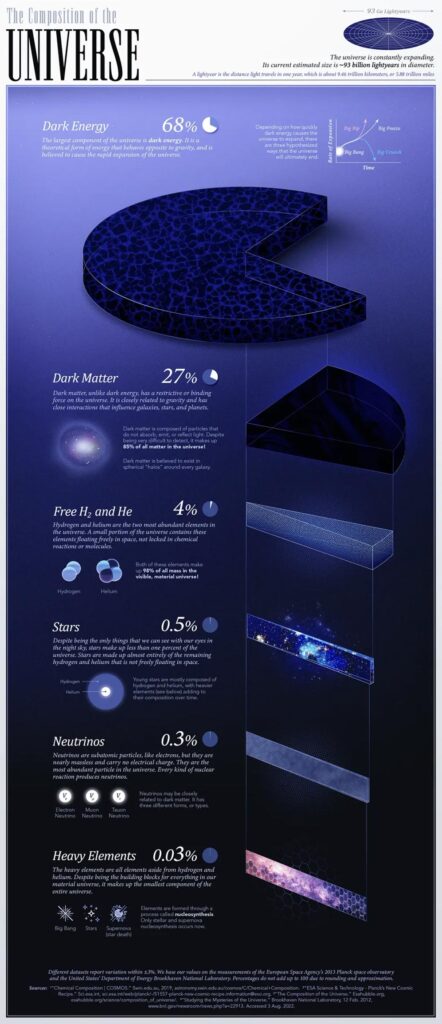Mark Belan – Përbërja e Universit (Infografikë), 2024
Senad Guraziu

…bazuar në këtë infografikë, universi madje as që e përmend Amerikën, Evropën, Putinin, Trumpidentin, Orientin, Azinë, Afrikën, Oksidentin, specien e njeriut, edhe Toka (si planet) askund, totalisht e padukshme, mund t’jetë ndonjë mikrogrimcë pluhuri diku në askundësi, ndërsa ne vazhdojme me bujën, me poteren politike, me luftrat e me ngatërresat, por sidoqoftë prapë kot, e qartë universi thjesht s’u mërzitka për ne : )
| – – –
…e gjithë historia njerëzore pothuaj sikur është një “luftë e gjaaatë”. Njeriu që nga kur diti për veten, prore duke luftuar, kurrë s’u ndal, as dhe sot e kësaj dite. Filozofikisht, më së thjeshti të thuhet: lufta është “natyra” jonë, dhe e gjithçkaje të gjallë. Metaforikisht aq e lehtë, madje mund dhe ta ndiejmë si vërtetësi, “jeta është luftë”, mbijetesë. Biologjikisht dihet, jeta është vajtje-ardhje napoleonike skenave mikro-dioramike. Frymëmarrja jonë në fakt është rezultat funksional i “luftës”… së një sistemi jashtëzakonisht kompleks, i cili ngërthen miliarda procese, sulme, mbrojtje, kundërsulme, dorëzime, fitore, negociata paqësore, armpushime… sa marramendja.
Qëkur, për “dominionet” e tyre tokësore mes vete luftojnë madje dhe vetë perënditë, atëherë s’do kishte kuptim që njeriu të shtiret “paqësor”, gjoja më pacifist sesa vetë perënditë. Që nga zanafilla, asnjë vegël… e as ato të luftës, as shtizat primitive neandertaleske nuk qenë shpikur kot, kam frikë… as bombat e sotme monstruoze bërthamore. S’e kujt i “duheshin” këto të fundit s’e kam idenë, por thuase një Ares i sherreve dhe i luftrave njeriun kurrë s’do ta lërë të qetë.
S’janë vetëm fjalë (gjoja zhgënjimtare, laicistike), nëse statistikat tingëllojnë sadopak më “afër” shkencës, atëherë sipas G. Elliot (“Twentieth Century Book of the Dead”, 1972 – University Library, Amsterdam) “gjatë periudhës 3360-vjeçare të historisë njerëzore kishte vetëm 227 vjet paqe”.
Dmth. numri i tij sikur na e thotë gjithçka shkurt e troç. Nëse i analizojmë vetëm 3000 e ca vjet, mbi 3000… njeriu thjesht duke luftuar. Siç e shohim, ka tepër shumë dallim 200 vjet paqe me 3000 vjet luftë, fatkeqësisht… kot nëse pandehim do duhej t’ishte e kundërta (3000 vjet paqe), por jo.
Apo, statistika tjetër na thotë: “…nga v. 1500 pes. e deri në vitin 1860 janë nënshkruar mbi 8000 kontrata për paqe, të cilat mesatarisht s’kanë zgjatur më tepër se 2 vite”. Ç’të thuhet tjetër – s’është as nevoja, lufta është thjesht “natyra” njerëzore!
| – – –
[ Senad Guraziu – “Troja Hipotetike – Ilioni Greko-Romak, dhe ‘Nëntë Trojat’ Arkeologjike!” – 2019, Ars Poetica ]
> >
Mark Belan – The Composition of the Universe (Infographic), 2024
***
…based on this infographic, the universe doesn’t even mention America, Europe, Putin, Trumpident, Orient, Asia, Africa, Occident, the universe doesn’t even mention the human species, and Earth (as a planet) also nowhere, totally invisible, could be a tiny speck of dust somewhere in nowhere, while we continue with the fuss, the political uproar, the wars and the confusion, but anyways, it’s clear, the universe simply doesn’t care about us : )
***
Scientists agree that the universe consists of three distinct parts: everyday visible (or measurable) matter, and two theoretical components called dark matter and dark energy.
These last two are theoretical because they have yet to be directly measured – but even without a full understanding of these mysterious pieces to the puzzle, scientists can infer that the universe’s composition can be broken down into the following components:
Dark Energy
Dark energy is the theoretical substance that counteracts gravity and causes the rapid expansion of the universe. It is the largest part of the universe’s composition, permeating every corner of the cosmos and dictating how it behaves and how it will eventually end.
Dark Matter
Dark matter, on the other hand, has a restrictive force that works closely alongside gravity. It is a sort of “cosmic cement” responsible for holding the universe together. Despite avoiding direct measurement and remaining a mystery, scientists believe it makes up the second largest component of the universe.
Free Hydrogen and Helium
Free hydrogen and helium are elements that are free-floating in space. Despite being the lightest and most abundant elements in the universe, they make up roughly 4% of its total composition.
Stars, Neutrinos, and Heavy Elements
All other hydrogen and helium particles that are not free-floating in space exist in stars.
Stars are one of the most populous things we can see when we look up at the night sky, but they make up less than one percent – roughly 0.5% – of the cosmos.
Neutrinos are subatomic particles that are similar to electrons, but they are nearly weightless and carry no electrical charge. Although they erupt out of every nuclear reaction, they account for roughly 0.3% of the universe.
Heavy elements are all other elements aside from hydrogen and helium.
Elements form in a process called nucleosynthesis, which takes places within stars throughout their lifetimes and during their explosive deaths. Almost everything we see in our material universe is made up of these heavy elements, yet they make up the smallest portion of the universe: a measly 0.03%.
Dark energy 68%
Dark matter 27%
Free hydrogen and helium 4%
Stars 0.5%
Neutrinos 0.3%
Heavy elements 0.03%
Data sources
https://astronomy.swin.edu.au/cosmos/C/Chemical+Composition
https://www.visualcapitalist.com/composition-of-the-universe/